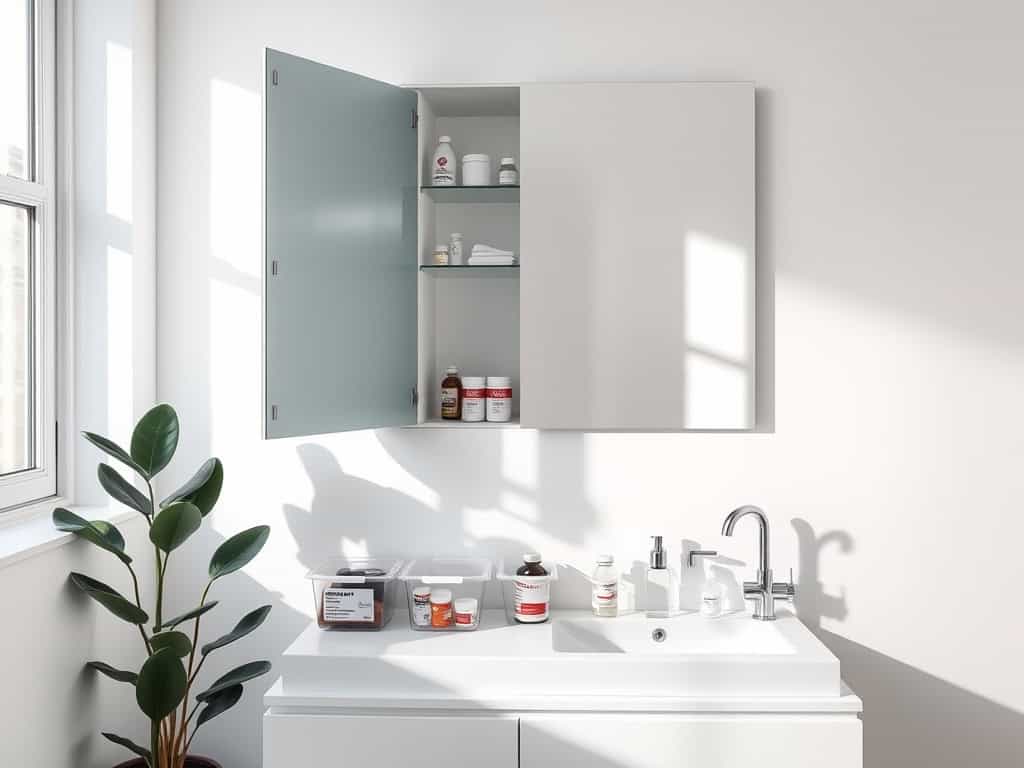Whether you’re managing daily medications, storing first-aid supplies, or organizing medical equipment, keeping your home medical supplies organized isn’t just about convenience—it’s about safety and peace of mind. I’ve learned through years of caregiving that a well-planned storage system can make the difference between calm confidence and frantic searching during an emergency. Let me share eight smart solutions that’ll transform your medical supply chaos into an organized, accessible system you’ll love!

Clear Storage Containers With Dividers

Organizing medical supplies in clear storage containers with dividers is crucial for maintaining quick access to essential items during medical emergencies or routine care. Proper organization ensures that medications, first aid supplies, and medical tools are easily visible and accessible while protecting them from dust, moisture, and potential contamination.
Clear containers with dividers serve as an ideal storage solution by allowing immediate visual identification of supplies while keeping items separated and preventing them from shifting or becoming tangled. This systematic approach reduces stress during urgent situations and helps track inventory levels at a glance, ensuring essential supplies are always stocked and readily available.
Required Items:
- Clear plastic storage containers with secure lids
- Adjustable drawer dividers
- Label maker or waterproof labels
- Medical-grade silica gel packets
- Measuring tape
- Clean microfiber cloth
- Small bins or cups for additional compartmentalization
- Medical supply inventory list
- Rubber drawer liner (non-slip)
Select appropriately sized clear containers based on your medical supply inventory and available storage space. Install adjustable dividers to create compartments that accommodate different-sized items, ensuring each section is properly sized for its contents.
Group similar items together, such as keeping all wound care supplies in one section and medications in another. Place frequently used items in easily accessible front compartments.
For medications, create designated spaces using smaller containers within the main storage container, ensuring proper temperature control and protection from light exposure. Use silica gel packets to control moisture levels, particularly for items sensitive to humidity.
Implement a clear labeling system that includes expiration dates, contents, and any specific storage requirements.
Additional Tips: Conduct monthly inventory checks to rotate supplies based on expiration dates and maintain appropriate stock levels. Install motion-sensor lighting in storage areas for better visibility, and keep a master inventory list attached to the container lid.
Consider using color-coded labels or zones for different categories of supplies, making identification even faster during urgent situations. Always store containers in a cool, dry place away from direct sunlight to preserve the integrity of medical supplies.
Medication Tracking & Labeling Systems
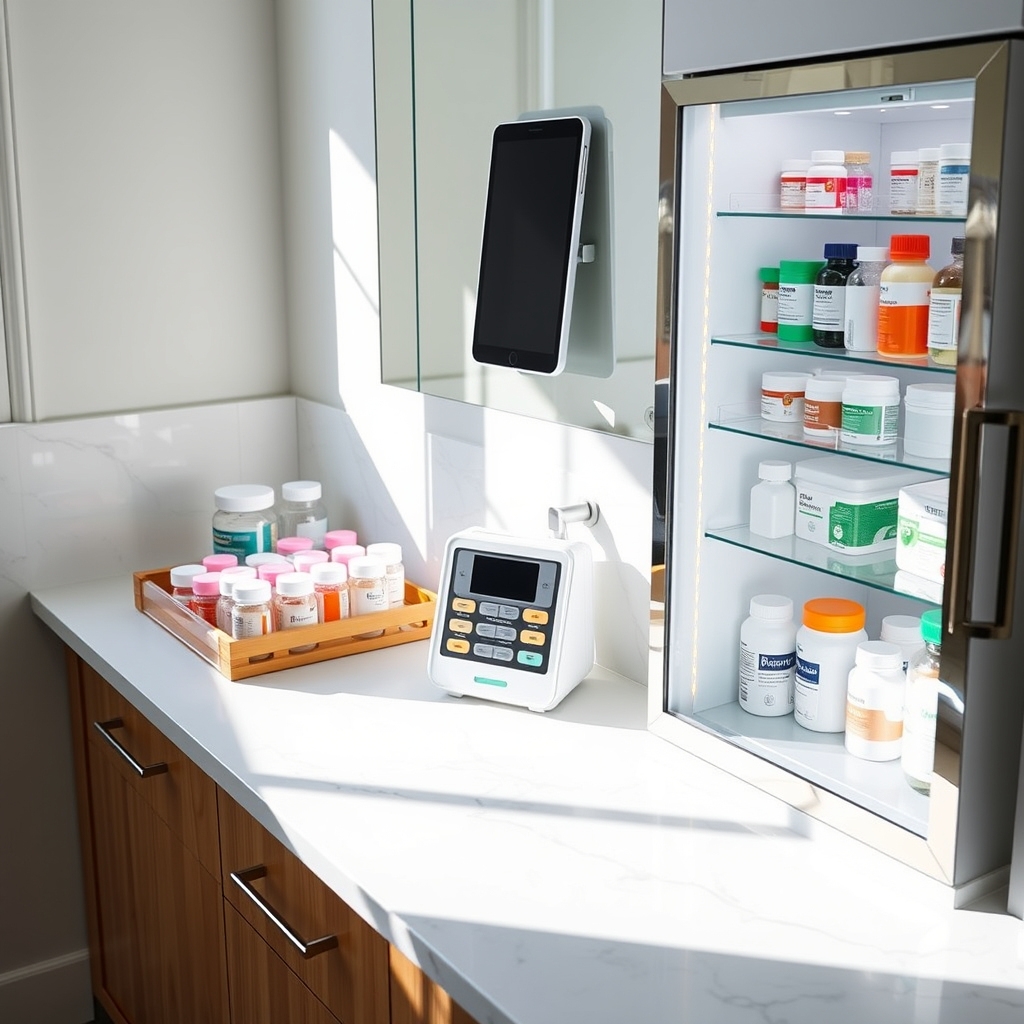
Proper medication tracking and labeling is crucial for maintaining health and safety in any household. Disorganized or incorrectly stored medications can lead to dangerous mistakes, missed doses, or expired medications being accidentally consumed. A well-organized system ensures that all household members can easily locate, identify, and track their medications.
Creating an efficient medication tracking and labeling system not only prevents potential medical emergencies but also helps maintain accurate inventory control. This organization method allows you to quickly identify when prescriptions need refilling, which medications are expiring, and ensures that different family members’ medications remain properly separated and clearly marked.
Required Items:
- Label maker or waterproof labels
- Clear storage containers
- Medicine cabinet or lockable storage
- Medication log book or digital tracking app
- Color-coded stickers or markers
- Small bins or drawer organizers
- Calendar or reminder system
- Pill organizers
- Storage bags with resealable closure
- Index cards for medication information
Set up your medication tracking system by first sorting all medications by family member, then by type (prescription, over-the-counter, supplements). Create clear, readable labels for each container including the medication name, dosage, frequency, and any special instructions.
Implement a color-coding system where each family member has their designated color for easy identification. Establish a centralized medication log, either digital or physical, recording essential information such as prescription numbers, doctor contact information, refill dates, and any noted side effects.
Set up automatic reminders for medication schedules using smartphone apps or a programmable system that works with your smart home devices. For maximum effectiveness, perform weekly medication checks to ensure proper organization and update tracking systems.
Keep a backup inventory list, regularly dispose of expired medications through proper channels, and maintain open communication with all household members about any changes to medication routines or storage locations. Consider keeping emergency medical information easily accessible, including medication allergies and current prescription details.
Temperature-Controlled Storage Solutions
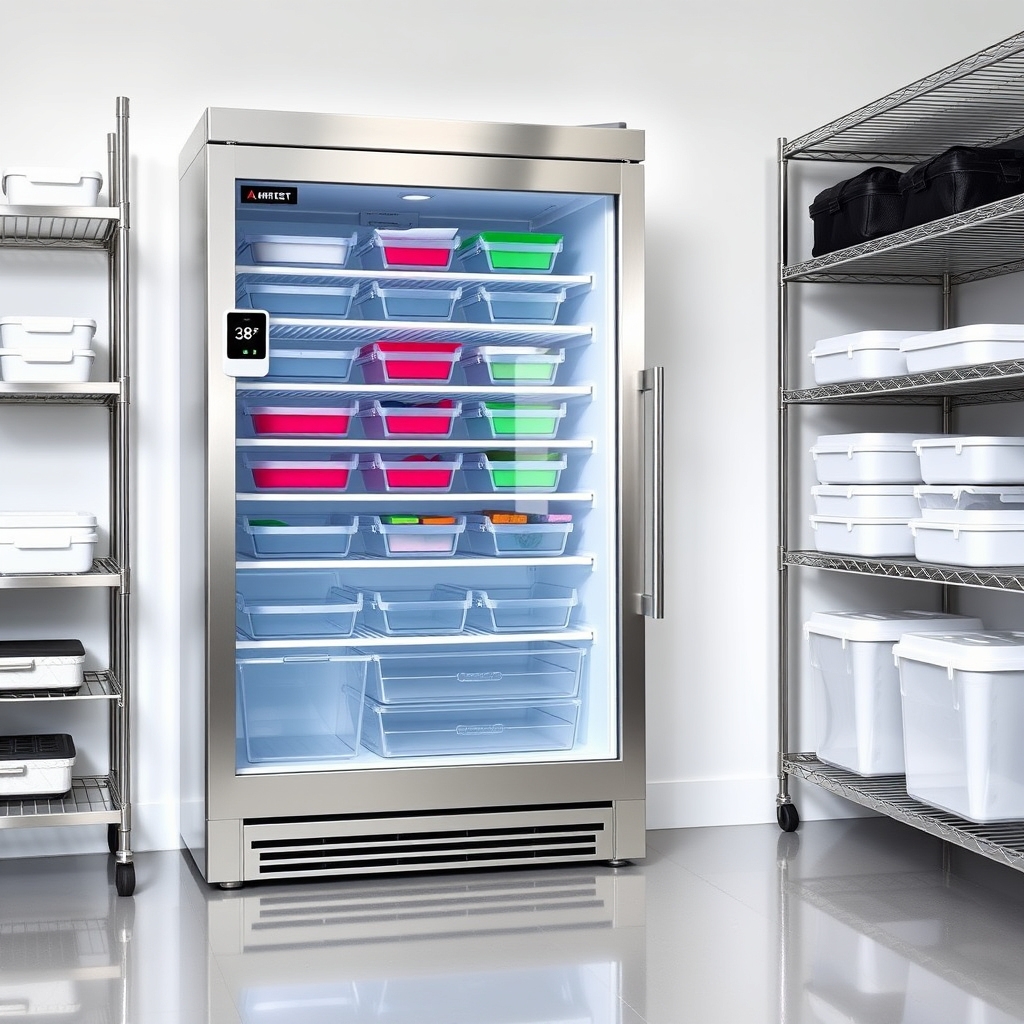
Proper temperature control for medical supplies is crucial for maintaining their effectiveness and preventing degradation. Many medications, medical devices, and supplies require specific temperature ranges to remain viable, making organized temperature-controlled storage a critical component of home healthcare management.
Creating an efficient temperature-controlled storage system not only preserves the integrity of medical supplies but also helps track inventory, prevent waste, and ensure quick access during medical situations. A well-organized system can mean the difference between properly stored medications and costly replacements due to temperature damage.
Required Items:
- Refrigerator with adjustable temperature controls
- Digital thermometer
- Storage bins with secure lids
- Label maker
- Temperature monitoring system
- Moisture-absorbing packets
- Airtight containers
- Insulated storage bags
- Battery backup system
- Storage rack or shelving unit
Select a dedicated refrigerator or cooling unit specifically for medical supplies, setting it to the appropriate temperature range (typically 36-46°F/2-8°C for most refrigerated medications). Install a reliable temperature monitoring system with alerts to track any fluctuations.
Organize supplies within the unit using clear, labeled containers, placing frequently-accessed items at eye level and grouping similar items together. Create a detailed inventory system that includes temperature requirements and expiration dates for each item.
For supplies requiring room temperature storage (59-77°F/15-25°C), designate a separate area away from direct sunlight, heat sources, and humidity. Use airtight containers with moisture-absorbing packets to protect sensitive items.
Implement a rotation system based on expiration dates, placing newer items behind older ones to ensure proper usage order.
Additional Tips:
Maintain a backup power source for temperature-controlled units to prevent supply damage during power outages. Regularly check and document temperatures twice daily, keeping a log of any fluctuations.
Consider installing a smart monitoring system that sends alerts to your phone when temperatures fall outside acceptable ranges. Clean storage areas monthly and inspect seals on storage containers quarterly to ensure proper temperature maintenance.
Space-Saving Wall-Mounted Organizers
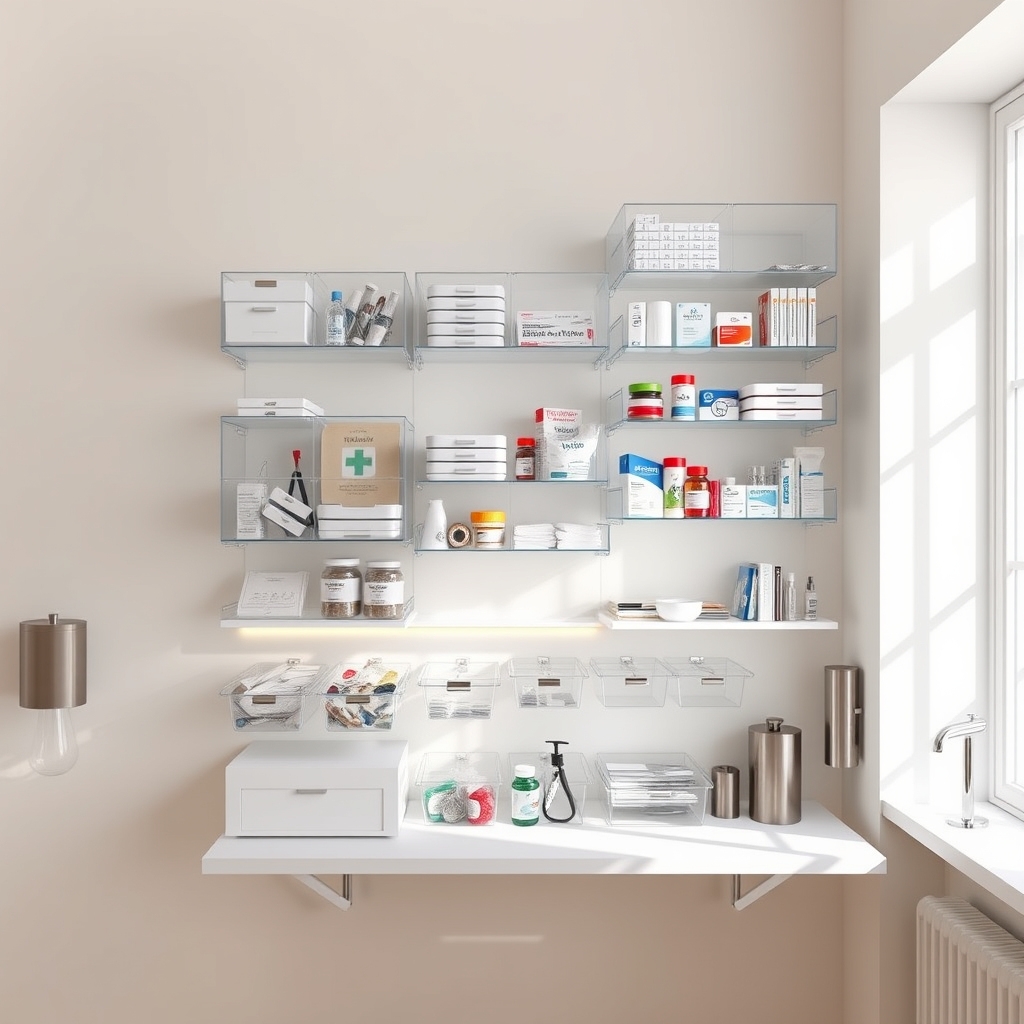
Organizing medical supplies in wall-mounted units serves as a critical solution for homes where floor space is limited and quick access to medical items is essential. Proper organization not only maximizes available space but also ensures that vital medical supplies remain visible, accessible, and protected from moisture or damage.
Wall-mounted organizers transform unused vertical space into functional storage areas while keeping medical supplies off countertops and out of cabinets. This organization method creates a dedicated medical zone that can be easily monitored for expired items and restocked as needed, making it particularly valuable for individuals managing chronic conditions or families with regular medical needs.
Required Items:
- Wall-mounted cabinet or shelving unit
- Clear plastic bins or containers
- Label maker or labels
- Mounting hardware
- Drill and screwdriver
- Level
- Measuring tape
- Storage hooks
- Clear plastic bags
- Shelf liner
- Anchors appropriate for wall type
Select a wall location that’s easily accessible but away from direct sunlight and moisture. Install the mounting hardware according to manufacturer specifications, ensuring proper anchor use for your wall type.
Organize supplies into categories such as first aid, medications, daily medical tools, and emergency supplies. Place frequently used items at eye level, with heavier items on lower shelves. Use clear containers to maintain visibility and add labels with contents and expiration dates. Install additional hooks for items like blood pressure cuffs or medical bags.
Consider incorporating these specialized tips: Use silica gel packets in containers to control moisture, implement a color-coding system for different family members’ supplies, and create an inventory list to track expiration dates.
Install motion-sensor lights for nighttime access, and maintain a small notepad nearby for logging when supplies need replacement. Regular reviews of the organization system ensure it continues to meet changing medical needs while maintaining efficiency and accessibility.
Mobile Medical Supply Carts

Organizing mobile medical supply carts is crucial for maintaining quick access to essential medical items while ensuring they remain secure and properly stored. A well-organized medical cart can mean the difference between a smooth care routine and frustrating delays when medical supplies are needed urgently.
Mobile medical carts serve as portable healthcare stations, bringing necessary supplies directly to where they’re needed in the home. Proper organization not only promotes efficiency but also helps maintain the integrity of medical supplies while preventing contamination and reducing the risk of errors in medication or supply selection.
Required Items:
- Mobile medical cart with drawers
- Drawer dividers/organizers
- Label maker
- Clear storage containers
- Sanitizing wipes
- Plastic bags
- Rubber drawer liners
- Small bins
- Medical supply inventory list
- Color-coding stickers
Start by completely emptying the cart and cleaning all surfaces thoroughly with sanitizing wipes. Group similar items together: medications, wound care supplies, diagnostic tools, and disposable items.
Install drawer liners to prevent items from sliding around during cart movement. Utilize drawer dividers to create designated spaces for different categories of supplies, ensuring items remain separated and easily accessible.
Position frequently used items in the top drawers for quick access, while storing backup supplies in lower drawers. Implement a clear labeling system for each drawer and compartment, including expiration dates where applicable. Arrange items so that those with the nearest expiration dates are placed in front, following the first-in-first-out principle.
To maintain optimal organization, conduct weekly inventories of supplies, immediately replace used items, and regularly check expiration dates.
Consider implementing a color-coding system for different categories of supplies, and maintain a master inventory list attached to the cart. These practices will ensure the cart remains functional and reliable for daily medical care needs while minimizing the risk of supply shortages or expired items.
Bathroom Cabinet Maximizers
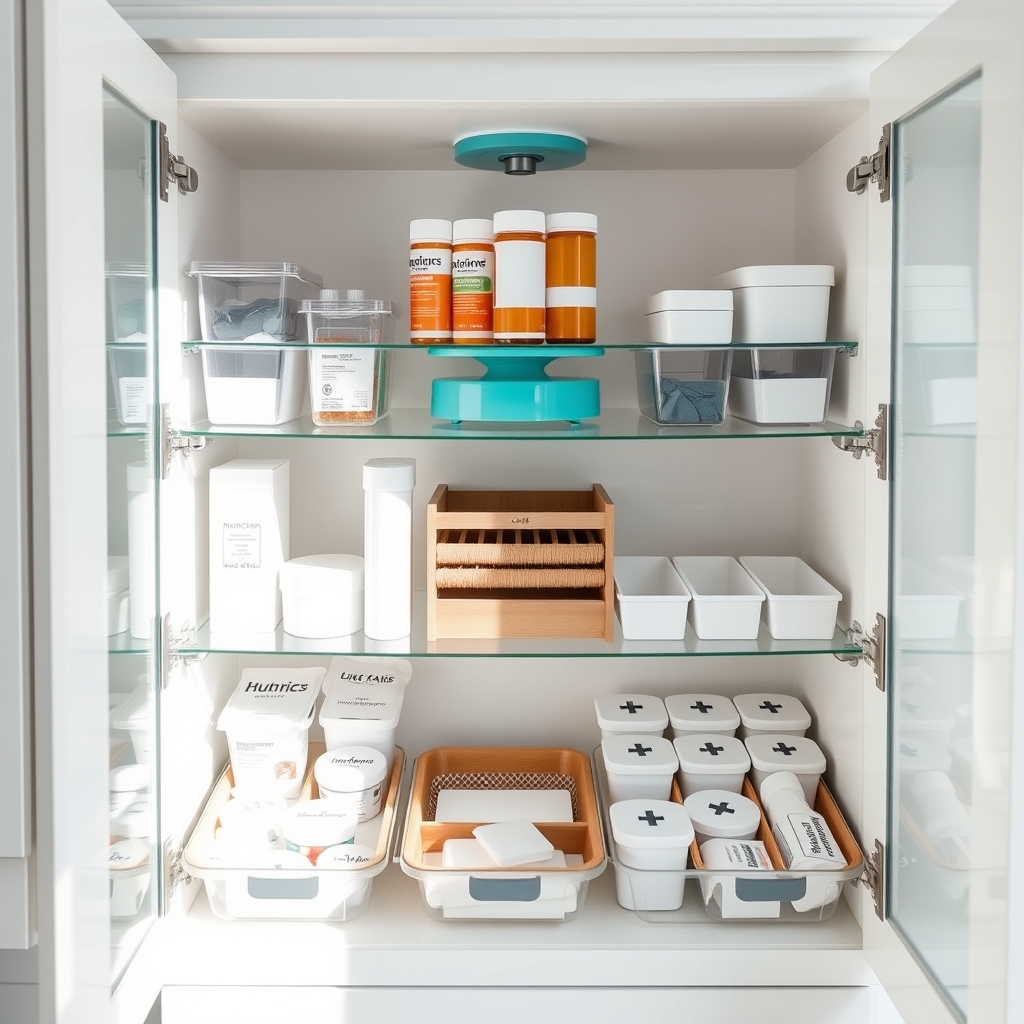
Organizing bathroom cabinets for medical supplies is crucial for maintaining quick access during emergencies and ensuring medications and first aid items remain easily accessible. Proper organization can mean the difference between fumbling through cluttered spaces and immediately locating essential items when needed.
Well-organized bathroom cabinet storage not only maximizes limited space but also helps maintain the integrity of medical supplies by protecting them from bathroom moisture and temperature fluctuations. Strategic organization can extend the life of medications and supplies while making daily medication management more efficient.
Required Items:
- Clear plastic bins
- Label maker or waterproof labels
- Shelf liner
- Small lazy susans
- Medicine bottle organizers
- Drawer dividers
- Clear storage containers
- Moisture-absorbing packets
- Pull-out drawer organizers
- Over-the-door organizers
Start by completely emptying the cabinet and cleaning all surfaces thoroughly. Group similar items together: daily medications, first aid supplies, bandages, and occasional-use items.
Install moisture-resistant shelf liner to protect supplies from bathroom humidity. Position frequently used items at eye level, utilizing clear containers for easy visibility. Place daily medications in designated organizers with clearly marked morning, afternoon, and evening compartments.
Install pull-out drawers or lazy susans in deep cabinets to maximize corner spaces and prevent items from being lost in the back. Use vertical space efficiently by incorporating stackable containers and over-the-door organizers. Sort bandages and first aid supplies into clearly labeled bins, positioning them in order of frequency of use. Create a designated space for prescription medications separate from over-the-counter items.
Additional Tips: Check expiration dates monthly and maintain an inventory list inside the cabinet door. Consider temperature-sensitive items that may need alternative storage locations. Use silicon moisture-absorbing packets in containers to protect supplies from humidity, and implement a rotation system for items with expiration dates.
Review and adjust the organization system quarterly to ensure it continues to meet your needs effectively.
Under-Bed Storage Solutions
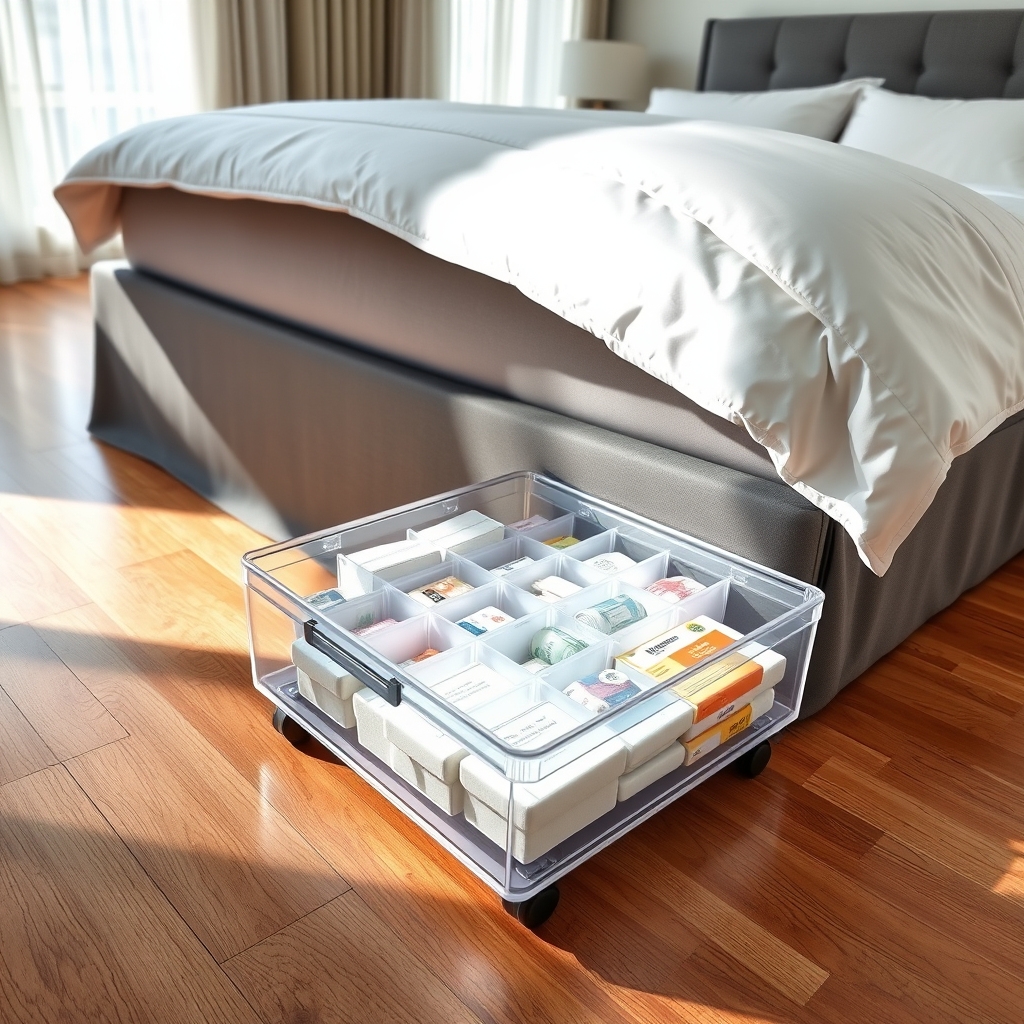
Utilizing the space under your bed for medical supply storage is a practical solution that combines accessibility with discretion. This often-overlooked area offers considerable storage potential while keeping essential medical supplies within easy reach, particularly important for those with mobility issues or who require frequent access to medical items.
Proper organization of under-bed storage can significantly reduce stress during medical emergencies and daily care routines. By implementing a systematic approach to storing supplies beneath the bed, you create a clean, organized space that protects medical items from dust while maintaining their integrity and accessibility.
Required Items:
- Under-bed storage containers with wheels
- Clear plastic bins with lids
- Storage dividers or organizers
- Labels and label maker
- Measuring tape
- Dust-proof cover or bed skirt
- Anti-humidity packets
- Clear plastic bags for sorting
- Inventory checklist
Begin by measuring the available space under your bed, including height clearance and depth. Sort medical supplies into categories such as daily use items, emergency supplies, and backup supplies. Place frequently accessed items toward the front of the storage area and less-used items toward the back.
Use clear containers with wheels for easy access and visibility, ensuring all containers are properly labeled with contents and expiration dates. Implement a grid system using storage dividers to create designated zones under the bed. Maintain organization by using smaller containers within larger ones to separate similar items.
Position emergency supplies closest to the side of the bed where they’re most likely to be needed. Consider using vacuum-sealed bags for bulkier items like bandages or disposable supplies to maximize space.
Additional Tips: Maintain a detailed inventory list posted on the wall or inside your closet door, and update it monthly. Include emergency contact information with the storage system.
Consider raising your bed with risers to create additional storage space if needed. Use silica gel packets in containers to prevent moisture damage, and schedule quarterly cleaning and reorganization sessions to ensure all supplies remain in optimal condition and are within their expiration dates.
Security Lockboxes for Sensitive Items
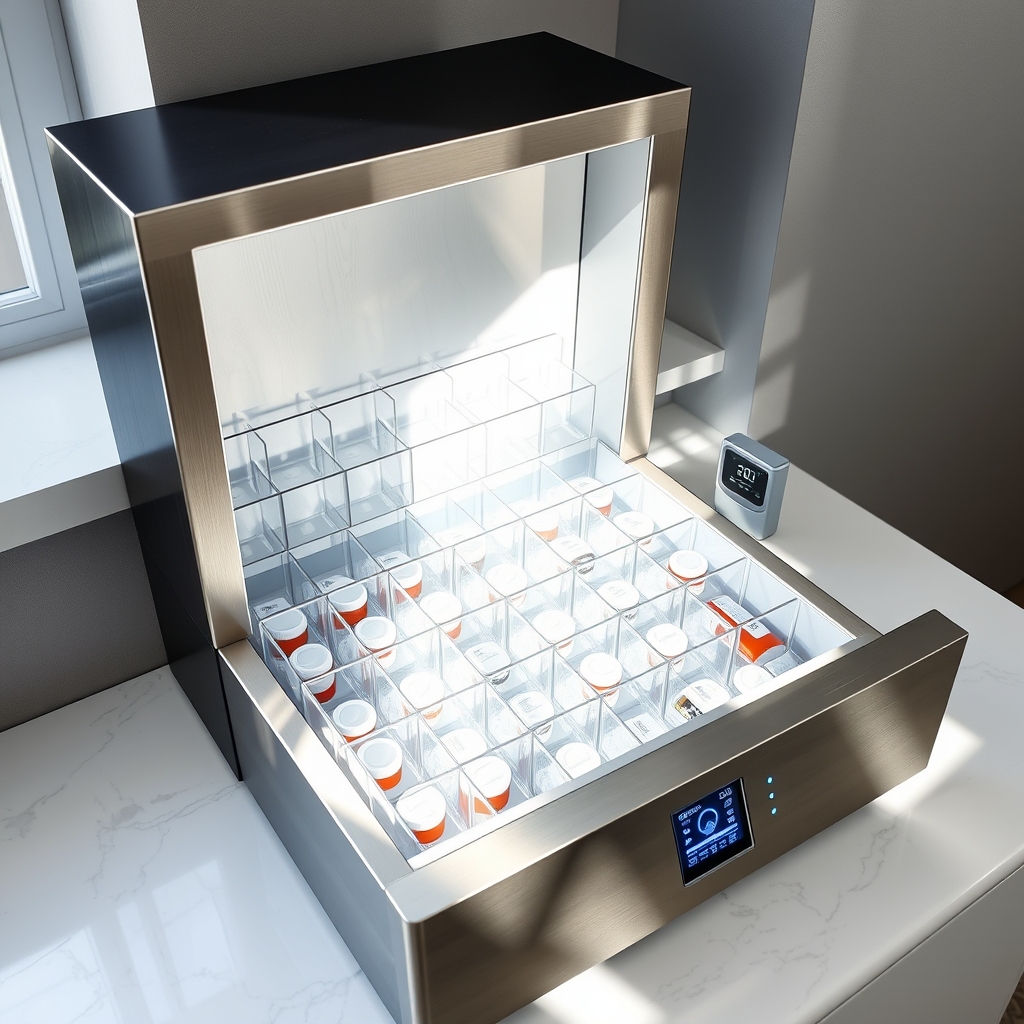
Secure storage of sensitive medical supplies is crucial for maintaining both safety and compliance in the home environment. Proper organization of security lockboxes ensures that potentially dangerous medications, sharp objects, and controlled substances remain accessible to authorized individuals while preventing unauthorized access or potential misuse.
A well-organized security lockbox system not only protects vulnerable household members but also helps track inventory levels and expiration dates of sensitive medical supplies. This systematic approach to storage can prove invaluable during medical emergencies when quick access to specific items is essential.
Required Items:
- Combination or biometric lockbox
- Medication dividers or organizers
- Label maker
- Inventory log sheet
- Small containers or bags for sorting
- Moisture-absorbing packets
- Emergency contact list
- Permanent marker
- Clear plastic bags
- Basic cleaning supplies
The organization process begins with selecting an appropriate location for the lockbox – ideally in a cool, dry space away from direct sunlight and heat sources.
Sort medications and sensitive items into categories such as daily medications, emergency supplies, and sharps. Create clearly labeled sections within the lockbox using dividers or small containers, ensuring that frequently accessed items are easily reachable.
Implement a logging system to track access to the lockbox, including dates, times, and items removed or added. This documentation helps maintain accurate inventory levels and provides accountability. For medications, arrange them by frequency of use and establish a clear system for monitoring expiration dates.
Consider using color-coding or symbolic labels for quick identification during emergencies.
Additional Tips: Regularly audit the contents of security lockboxes, checking for expired items and updating the inventory log. Keep a backup key or combination in a separate secure location, and maintain a list of authorized users.
Consider installing a humidity monitor if storing moisture-sensitive items, and schedule quarterly deep-cleaning of the lockbox interior to prevent contamination and maintain organization.

